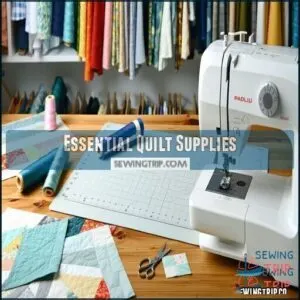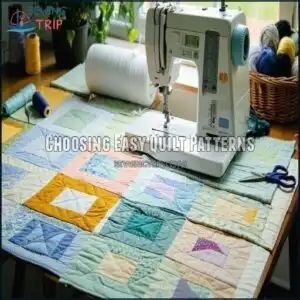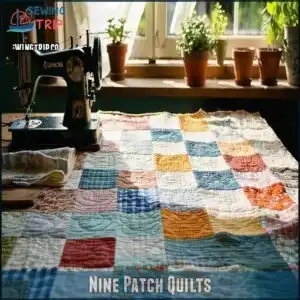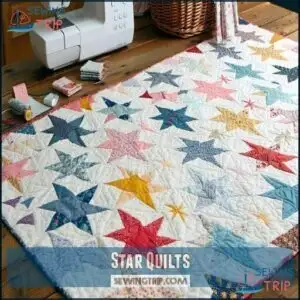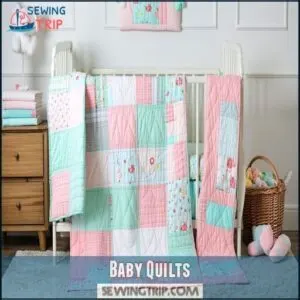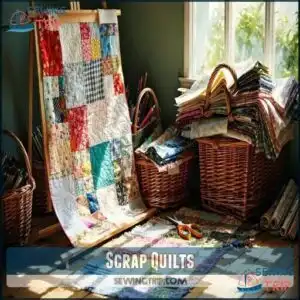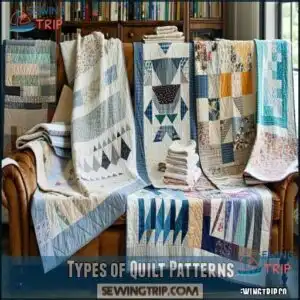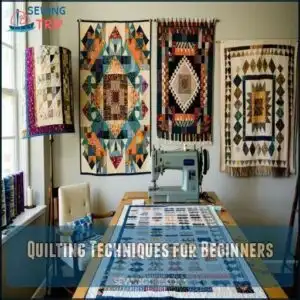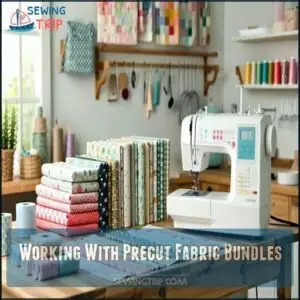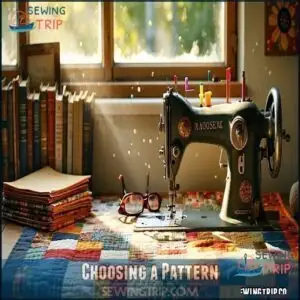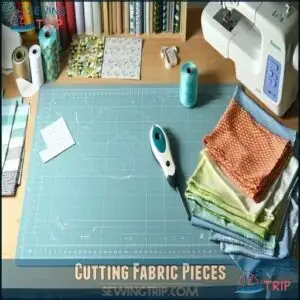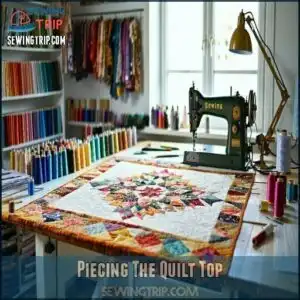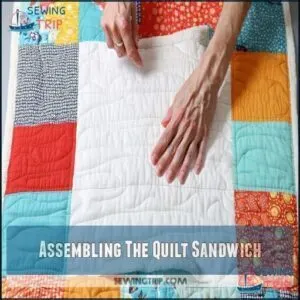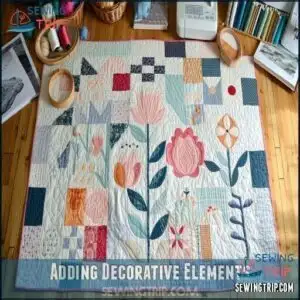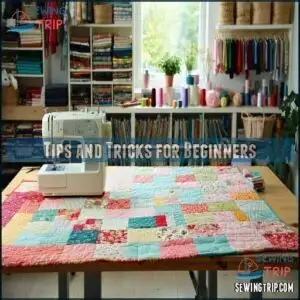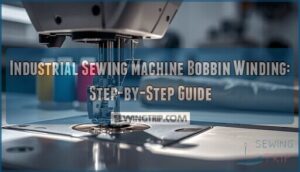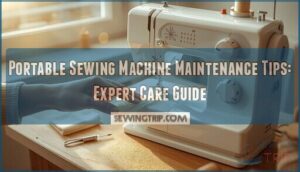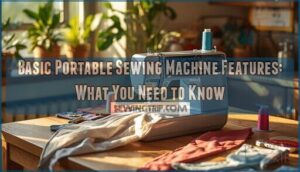This site is supported by our readers. We may earn a commission, at no cost to you, if you purchase through links.
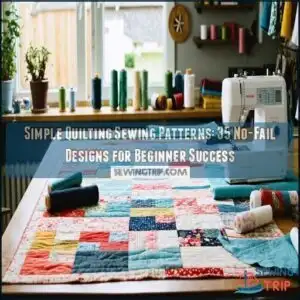
Precut fabric bundles, such as charm packs or jelly rolls, can save time and make your projects easier. Focus on patterns with clear instructions and easy assembly, like baby quilts or scrap quilts.
Tools like a rotary cutter, cutting mat, and a reliable sewing machine will make the process smoother. Once you’ve mastered the basics, try block-based quilts or add appliqué for extra flair.
Ready to stitch? You’ll be surprised how quickly confidence grows!
Table Of Contents
- Key Takeaways
- Essential Quilt Supplies
- Choosing Easy Quilt Patterns
- Easy Quilt Patterns for Beginners
- Types of Quilt Patterns
- Quilting Techniques for Beginners
- Working With Precut Fabric Bundles
- Creating a Quilt From Start to Finish
- Adding Decorative Elements
- Tips and Tricks for Beginners
- Frequently Asked Questions (FAQs)
- Conclusion
Key Takeaways
- Start with beginner-friendly patterns like Nine Patch, Four Patch, or strip-pieced designs that use simple shapes like squares or strips.
- Use precut fabric bundles like charm packs or jelly rolls to save time and simplify your quilting projects.
- Invest in essential tools like a rotary cutter, cutting mat, and a reliable sewing machine for smoother quilting.
- Focus on step-by-step patterns with clear instructions to build skills and confidence.
Essential Quilt Supplies
You’ll need a few basic tools to start your quilting journey, including a rotary cutter, cutting mat, sewing machine, thread, and a quarter-inch foot for accurate seams.
Start your quilting journey with essential tools like a rotary cutter, cutting mat, sewing machine, thread, and a quarter-inch foot.
Good supplies make quilting easier and more enjoyable, so don’t skimp on essential items that you’ll use for many projects to come, as good supplies are crucial.
Rotary Cutter and Mat
A good rotary cutter and mat form the foundation of successful quilting.
These essential tools transform fabric cutting from tedious to enjoyable.
- Blade sharpness guarantees clean cuts through multiple fabric layers without fraying or distortion
- Mat maintenance extends its life – rotate regularly and keep it flat on a smooth surface
- Accurate cutting techniques require firm pressure and proper fabric gripping for precise results
Using the right cutting mat features can substantially improve the overall quilting experience.
Sewing Machine and Accessories
While your rotary cutter makes precise cuts, a reliable sewing machine forms the backbone of quilting. Brother, Singer, and Janome offer beginner-friendly options.
Select universal needles for quilting cotton. When choosing a machine, consider the benefits of quilting machine features to enhance your sewing experience.
piecing
Stock quality universal sewing needles for quilting stitches.
Iron and Ironing Board
A proper iron and ironing board transform your quilting experience from frustrating to fantastic.
These essential tools guarantee crisp seams and precise piecing in your quilting projects.
Here are three ironing tips for beginners:
- Adjust steam settings based on fabric type – cotton needs more, delicate fabrics less
- Replace board covers when worn for smoother pressing surfaces
- Press (don’t iron) by lifting and placing rather than sliding the iron, which helps achieve precise piecing and prevents damage to your quilt.
By following these tips and using the right tools, you can ensure a fantastic quilting experience.
Local Quilt Shops and Online Retailers
Local quilt shops buzz with creative energy, offering personalized guidance from experienced quilters and fabric sales you can touch before buying.
These community hubs often host quilt classes and shop tours that online retailers can’t match.
Meanwhile, digital quilting supplies marketplaces provide convenience, competitive retail discounts, and helpful online reviews to compare prices and products while shopping in your pajamas.
Many quilters participate in local quilt events to support their community and take advantage of local quilt events.
Choosing Easy Quilt Patterns
You’ll find success with quilting patterns that use simple shapes like squares and rectangles with fewer seams to match.
Starting with patterns that include step-by-step instructions and utilize precut fabric bundles will make your first quilting projects both manageable and rewarding.
Beginners’ Friendly Patterns
Beginners’ friendly patterns consistently offer the perfect starting point for your quilting journey.
Look for simple quilt designs like Nine Patch, Four Patch, or Rail Fence patterns that use basic shapes and straight lines.
Many beginner quilt patterns (free online!) include step-by-step photos and clear instructions, which are beginner-friendly and easy to follow.
Choose patterns labeled "easy" to guarantee success with your first quilting projects, ensuring a smooth start to your quilting experience with simple designs.
Patterns With Simple Shapes
Simple shapes are always the backbone of successful beginner quilt patterns.
Square patterns and basic blocks create beautiful quilts without overwhelming complexity.
- Geometric designs using squares and triangles build confidence with each stitch
- Simple quilt blocks like four-patch and nine-patch patterns offer quick satisfaction
- Patchwork basics teach essential skills while creating stunning visual effects
- Shape templates guarantee consistent cutting for professional-looking results
Start with these fundamentals before tackling more intricate designs.
Precut Fabric Bundles
Precut fabric bundles take the hassle out of measuring and cutting, saving you nearly 40% of project prep time.
For a different approach, learn how to sew bundles with closures.
Fat quarters (18" x 22"), jelly rolls (2.5" strips), layer cakes (10" squares), and charm packs (5" squares) come perfectly coordinated and ready to sew.
Prices typically range from $25-$60 depending on quality and piece count, making these bundles both time-efficient and budget-friendly for beginners keen to start quilting immediately.
Patterns With Detailed Instructions
While selecting pattern designs for your first quilting projects, prioritize those with detailed instructions for foolproof results.
Choose patterns featuring:
- Clear, step-by-step photos showing each stage
- Beginner guides with helpful tips and troubleshooting advice
- Video tutorials demonstrating tricky techniques
These detailed resources act as your personal quilting instructor, making simple quilting ideas achievable even when you’re working alone. Many free beginner quilt patterns include these valuable teaching elements.
Easy Quilt Patterns for Beginners
You’ll find these beginner-friendly quilt patterns use simple shapes and clear instructions to help you create beautiful projects without frustration.
These patterns feature straightforward techniques like strip piecing, four-patch blocks, and precut fabrics that make your quilting journey both manageable and rewarding.
Nine Patch Quilts
Nine patch quilts stand as the perfect starting point for new quilters. These classic patchwork blocks combine nine equal squares in a 3×3 grid, offering endless possibilities with minimal complexity.
Nine patch quilts are beginner-friendly classics, blending simplicity and creativity with nine easy squares for endless design possibilities.
You’ll love how this pattern works with any fabric selection – from coordinated collections to random scraps. Beginners find success because the straight seams and simple block construction build confidence quickly.
Try these variations:
- Traditional: alternating light and dark squares
- Disappearing: cut and rearrange completed blocks for complex-looking designs
- Scrappy: use leftover fabrics for an eclectic look
Experiment with different block sizes too – larger squares mean faster quilts, while smaller ones create more detailed designs. The basic nine patch teaches fundamental quilting tips while producing beautiful, usable results every time.
Understanding quilting patch patterns is essential for creating stunning quilts.
Star Quilts
Star quilts shine brightly with their enchanting patterns and classic appeal.
While they may look intricate, many designs are surprisingly beginner-friendly.
- Experiment with Star Blocks to master patchwork techniques.
- Tap into detailed tutorials for step-by-step Pattern Making.
- Embrace versatile Quilt Designs, perfect for any skill level.
- Choose bold Fabric Choices that bring your quilt to life.
- Practice Block Construction to build confidence in creating easy quilt patterns.
Baby Quilts
Soft fabrics and gentle colors make baby quilts perfect nursery accents or thoughtful gifts.
Crib quilt patterns are ideal for beginner quilting projects—letting you craft easy quilt patterns that are equal parts cute and practical.
Focus on baby-safe fabrics and simple quilt instructions to bring your designs to life.
Beginner-friendly style
Quick to assemble
Scrap Quilts
Scrap quilts are your chance to turn leftover fabric scraps into something beautiful and meaningful.
Using Scrap Quilt Patterns, you can craft a unique patchwork quilt that reflects your creativity and memories.
Try Scrappy Quilt Designs with easy quilt patterns like strip piecing for quick quilts.
Organize your scraps by size or color to simplify the process. Scrap organization isn’t just practical—it’s also fun!
With simple quilting patterns, scrap quilts keep quilting exciting and approachable for beginners.
Types of Quilt Patterns
You’ll find that quilt patterns come in a variety of styles, each offering a unique look and level of complexity.
From simple strip pieced designs to charming appliqué and rag quilts, there’s something for every beginner to enjoy.
Strip Pieced Quilts
If cutting countless tiny shapes isn’t your thing, strip quilting is perfect.
Sew fabric strips together, then slice them into pieced blocks for a simple yet gorgeous strip quilt.
It’s beginner-friendly and quicker than traditional methods, leaving more time to experiment with fabrics and quilting patterns for beginners.
Add flair with quilt borders or bold colors.
For smooth stitching, focus on straight seams—precision makes easy strip quilting for beginners even easier!
Block-Based Quilts
Block-based quilts are like crafting stories one piece at a time.
With endless options, they’re perfect for beginners exploring quilt blocks.
- Explore Variations: Mix sizes for creative patchwork designs.
- Master Precision: Focus on accurate seams for polished beginner quilt patterns.
- Experiment with Tradition: Blend classic patchwork quilt styles into fresh, easy quilt block patterns.
Start building masterpiece blocks today!
Appliqué Quilts
Appliqué quilts are a great way to personalize your projects with creative appliqué designs.
Use vibrant fabrics and lightweight fusible web for quick results or try applique quilts by hand for a traditional touch.
Focus on precise fabric placement, simple stitch techniques, and quality needle choices.
Beginner quilt patterns make learning how to applique easy techniques rewarding and fun!
Rag Quilts
Rag quilts are perfect for lazy evenings and quick projects. With Rag Quilt Basics, it’s easy to create that rustic, frayed charm.
Use fabrics like flannel or denim for warmth and soft edges.
- Rag Fabric: Flannel, denim, or cotton work best.
- Frayed Edges: Clip seams carefully for a cozy texture.
- Sewing Tips: Layer fabric squares for a clean quilt sandwich.
- Care Instructions: Wash gently to preserve softness.
Quilting Techniques for Beginners
You’ll build your skills with simple techniques like straight-line quilting, free-motion quilting, and hand quilting. Focus on mastering these basics to create beautiful quilts and finish them with confidence.
Straight-Line Quilting
Straight-line quilting is perfect for beginners seeking simple machine quilting success.
With just quilting tools like rulers and guides, you’ll create polished straight lines effortlessly.
Experiment with stitch length for a customized look, and balance quilt density to suit your design.
Use quilting tutorials to explore easy straight line quilting patterns, transforming your fabric selection into beautiful, clean designs.
Embrace this stress-free start to quilting!
Free-Motion Quilting
Free-motion quilting (FMQ) is your playground for creativity.
Using a darning foot, move fabric freely under the needle to create loops, swirls, or meanders.
Start small with easy quilting patterns, lightweight fabric, and 50-weight thread.
Adjust quilting speed to match your hand motion for smooth stitching.
Practice daily, watch quilting tutorials, and choose designs that inspire confidence.
Hand Quilting
Hand quilting brings timeless charm to handmade quilts.
Start by prepping fabric and selecting the right tools:
- Needle Choices: Opt for Quilter’s Betweens or Sharp Needles suited to quilting101 projects.
- Hand Stitches: Practice even stitches to perfect beginner quilting patterns.
- Quilt Frames: Use hoops or frames to stabilize fabric, ensuring easy stitching on applique quilts by hand.
Binding and Finishing
Once your quilt sandwich is stitched and quilted, finishing it off with quilt binding adds that polished charm.
Think of the binding as the frame for your masterpiece.
Use binding techniques to sew and wrap fabric around the quilt edging, carefully securing it with sewing seams.
Quilt tutorials often suggest straightline quilting here, ensuring clean, even edges.
These finishing touches complete your quilt construction beautifully.
Working With Precut Fabric Bundles
Precut fabric bundles like charm packs, jelly rolls, and layer cakes make quilting faster and easier by saving you time on cutting.
With uniform shapes and coordinated colors, they’re perfect for creating beautiful quilt patterns without the hassle.
Charm Packs
Charm packs are your quilting shortcut—5-inch squares of precut fabric that simplify your projects.
These bundles offer an effortless way to craft stunning block patterns or quilt designs without tedious cutting.
Pair them with sewing tips or layer cake inspirations to create hassle-free charm pack projects.
From beginner-friendly fabric selection to striking quilt ideas, charm packs free your creativity.
Understanding the charm pack size is essential for successful quilting projects and to ensure you make the most of your quilting shortcut with the right precut fabric.
Jelly Rolls
Jelly rolls—those handy bundles of 2.5" fabric strips—make strip quilting a breeze for beginners.
They save cutting time and offer endless creative options.
Explore jelly roll quilt projects like:
- Jelly roll races for fast, stunning quilts.
- Roll projects for simple borders or patterns.
- Swap strips for fabric savings and variety.
- Try easy quilting patterns for beginners using these precuts.
- Use quilt shortcuts to create quicker masterpieces.
Understanding jelly roll basics is key to discovering their full potential.
Layer Cakes
Layer cakes, 10-inch precut fabric squares, make quilting faster and more fun.
They’re ideal for countless quilt sizes and block designs. Ready-to-use, these Layer Cake Patterns eliminate cutting stress.
Benefits Details Projects
Cake Quilting transforms fabric into art!
Fat Quarters
Fat quarter bundles are your secret weapon for tackling projects with ease.
These 18×22-inch quilt fabric gems simplify precut fabric tips and provide endless options for creative quilt fabric selection.
Pair them with layer cake projects or charm packs for cohesive designs.
Their manageable size makes fat quarter storage simple and ideal for fabric scrap management.
Whether crafting a fat quarter mixer or trying quick precut fabric creations, these bundles make quilting approachable and fun.
Creating a Quilt From Start to Finish
You’ll create a quilt by following a clear, step-by-step process that guarantees each layer comes together smoothly.
Start by choosing a pattern, cutting your fabric, piecing the quilt top.
Assembling the layers into a finished masterpiece is the final step.
Choosing a Pattern
Choosing the right pattern is key to starting your quilting adventure.
For beginners, simple quilts like nine-patch or rail fence are fantastic beginner quilt patterns.
Look for easy quilting projects with clear instructions and manageable fabric requirements. Beginner tips suggest matching patterns to your fabric stash and focusing on simple design elements.
Beginner quilt patterns, such as log cabin or patchwork, offer satisfying results. Pattern selection should balance skill level, design elements, and your quilting time.
Cutting Fabric Pieces
Grab your rotary cutter and cutting mat—it’s time to bring your quilt’s fabric pieces to life! For accurate Fabric Cutting, align the fabric on your self-healing mat and pay close attention to the grain.
Proper Piece Accuracy guarantees smooth seams later, so don’t rush. Using templates or straight rulers can simplify the process, especially in patchwork for beginners.
Remember these tips:
- Always double-check measurements.
- Press fabric before cutting.
- Watch for consistent Seam Allowance.
- Keep blades sharp.
- Store Rotary Tools safely.
Quilting basics start here!
Piecing The Quilt Top
Piecing the quilt top is where your patchwork truly shines.
Start with a plan and follow these steps:
- Fabric Selection: Match colors and patterns to create harmony.
- Block Design: Lay out pieces in your chosen pattern.
- Seam Allowance: Keep a consistent 1/4-inch seam.
- Piecing Tips: Sew carefully and press seams flat for neat, easy patchwork quilts.
Enjoy watching your quilt layout come alive!
Assembling The Quilt Sandwich
You’ve mastered quilt top piecing—what’s next?
Time for sandwich construction! Lay your quilt top flat, spread batting evenly, and top it with backing fabric, just like building a cozy stack.
Smooth wrinkles as you go. Pin the quilt layers securely using safety pins for stability.
This quilt assembly step sets the stage for bringing quilting patterns to life beautifully!
Adding Decorative Elements
You can make your quilt stand out by adding decorative elements like embroidery, appliqué, or unique quilting stitches.
Simple touches like borders and edging give your project a polished and personal finish.
Embroidery
Embroidery adds personality to your quilt, making each stitch a little piece of art.
Start simple with embroidery stitches like running or backstitch. Use thread colors that contrast or complement your quilt for standout designs. Don’t forget to use fabric marking tools to plan your patterns.
- Try this:
- Match needle types with your thread and fabric.
- Experiment with hoop sizes for stability.
- Layer sewing patterns into your quilting designs.
Appliqué
Appliqué is like adding flair to your quilt with fabric pictures.
Using fabric scraps, explore easy ideas like sewing shapes in fabric—think hearts, stars, or flowers.
Beginners can try how to applique easy techniques like fusible webbing for neat edges.
Needle techniques like blanket stitches add charm.
For fabric cutting, precision matters.
Pair vibrant thread choices with simple sewing designs quilted onto your base for unique results.
It’s creative quilting freedom with the use of vibrant thread choices.
Quilting Stitches
Quilting stitches are where creativity shines. From simple straight lines to playful swirls, stitching transforms your quilt into a personal masterpiece.
Explore different sewing techniques using your sewing machine, like free-motion quilting or stitch-in-the-ditch. Here’s how to elevate your quilt:
- Experiment with Stitch Patterns: Curves, loops, or classic meanders add charm.
- Choose Quality Quilting Threads: Strong, smooth threads guarantee durability.
- Learn Beginner-Friendly Sewing Patterns: Straight-line quilting designs offer structure and style.
With these quilting tips, threading your fabric becomes an artful process worth celebrating.
Borders and Edging
Borders and edging are your quilt’s finishing touch, like a frame for your artwork.
Add personality with bold border designs or subtle quilt frames. Smooth quilt edges need clean edge finishing, while binding tips help secure everything neatly.
Enhance quilt designs with corner squares for added charm. With the right quilting techniques, your sewing patterns pop beautifully!
Tips and Tricks for Beginners
Start with small, simple projects to build your confidence and skills. Focus on pressing seams carefully and choosing fabrics that coordinate well for a polished look.
Choosing Colors
Picking colors is like painting your quilt’s personality! Start with a color palette you love and use color theory to balance hues.
Think about value contrast for depth and mix prints thoughtfully.
Here’s how:
- Choose fabrics with varying light and dark values.
- Select prints that complement your quilt design.
- Experiment with easy modern quilts or simple geometric quilts to create a balanced look.
Pressing and Ironing
Great seams? That’s where pressing shines. In quilting for beginners, pressing seams smooths your fabric and boosts precision.
- Iron Temperature: Match it to your fabric type—low for delicate, high for cotton.
- Pressing Tools: Try a tailor’s ham for tricky spots.
- Starch Alternatives: Use them sparingly to avoid stiffness.
- Ironing Board Care: Keep it clean and sturdy.
Troubleshooting Common Mistakes
Mistakes happen, but quilting for beginners is about learning, not perfection.
Fabric puckering? Check your tension and pin carefully. Seam problems or quilting mistakes? A consistent 1/4" seam saves headaches.
Cutting issues lead to mismatched quilt blocks, so measure twice! Binding troubles? Slow and steady wins.
Remember, sewing tips and tricks are your best friend. Here’s a quick guide:
Mistake Cause Fix
Frequently Asked Questions (FAQs)
Are there easy quilt patterns for beginners?
Simple patterns like patchwork squares, strip quilts, and plus quilts are beginner-friendly.
They use basic shapes, clear instructions, and pre-cut fabrics like jelly rolls or charm packs, making quilting a fun and stress-free start.
How do you make a free quilt pattern?
Creating a free quilt pattern is like building a road map.
Sketch your design, choose simple shapes, calculate sizes, and write clear instructions.
Test it, adjust if needed, and share digitally for others to enjoy!
What is a good quilt pattern?
A good quilt pattern depends on your skill level and goals.
For beginners, try simple patchwork or strip quilts.
They’re easy to follow and let you experiment with colors and designs without feeling overwhelmed.
What are some free quilt patterns?
Explore free quilt patterns online like the Plus Quilt, Fat Quarter Mixer, Star Patterns, or Strip Quilts.
Many designs use pre-cuts, scraps, and come with step-by-step instructions, perfect for beginner and experienced quilters alike, making them great for those looking for easy projects.
How do you make a quilt for a beginner?
Ever wondered how to turn fabric scraps into something magical?
Start small: pick a simple pattern, cut fabric accurately, sew pieces together, layer with batting and backing, quilt it, then bind the edges.
How many free sewing machine quilt patterns are there?
You’ll find hundreds of free sewing machine quilt patterns online, perfect for beginners and advanced quilters.
From simple patchwork to creative designs, these patterns often include step-by-step instructions, tutorials, and printable PDFs to follow, making them ideal for quilters of all levels with step-by-step guidance.
What is the golden rule in quilting?
90% of quilting success lies in precise seam allowances.
The golden rule in quilting is consistency—always sew with a 1/4-inch seam.
This keeps your blocks uniform, ensuring your quilt comes together beautifully without mismatches.
What is the most popular quilt pattern of all time?
The log cabin quilt pattern claims the top spot as the most popular of all time.
Its timeless design features overlapping fabric "logs" that create striking squares, perfect for beginners and cherished by seasoned quilters alike, with timeless design being a key aspect of its appeal, and the pattern is also notable for its striking squares.
What is the easiest quilting stitch?
The easiest quilting stitch is “stitch in the ditch.”
You sew straight lines along the seams of your quilt.
It’s beginner-friendly, keeps things simple, and helps you practice moving your quilt smoothly, which makes it a great choice for those looking for a beginner-friendly option.
What is the basic rule of quilting?
The basic rule of quilting is precision—cut your fabric accurately, sew with a consistent1/4" seam allowance, and press seams neatly.
Small details matter, and when combined, they create a polished, beautiful finished quilt.
Conclusion
Starting your quilting journey might feel overwhelming, but simple quilting sewing patterns make it achievable and fun.
With tools like rotary cutters and precut fabric bundles, you’ll quickly gain confidence.
Begin with easy designs like Nine Patch or baby quilts to practice basic techniques.
Focus on patterns with simple shapes and clear instructions, and don’t rush—enjoy the process, and before you know it, you’ll be stitching like a pro and creating quilts you’ll treasure forever.
- https://sewcanshe.com/35-easy-peasy-beginner-quilt-patterns-all-free/
- https://www.aquiltinglife.com/easy-quilt-patterns-for-beginners/
- https://www.fatquartershop.com/free-quilt-patterns/free-quilt-patterns-for-beginners
- https://www.polkadotchair.com/45-beginner-quilt-patterns-tutorials/
- https://www.reddit.com/r/quilting/comments/15z3n11/what_are_some_free_patterns_for_a_beginner/

